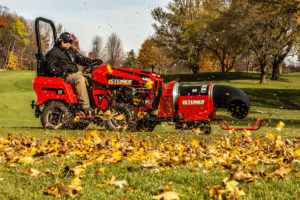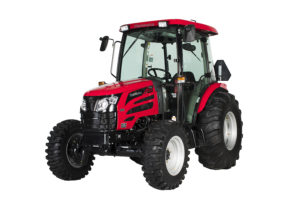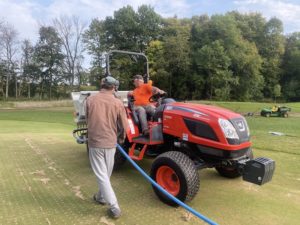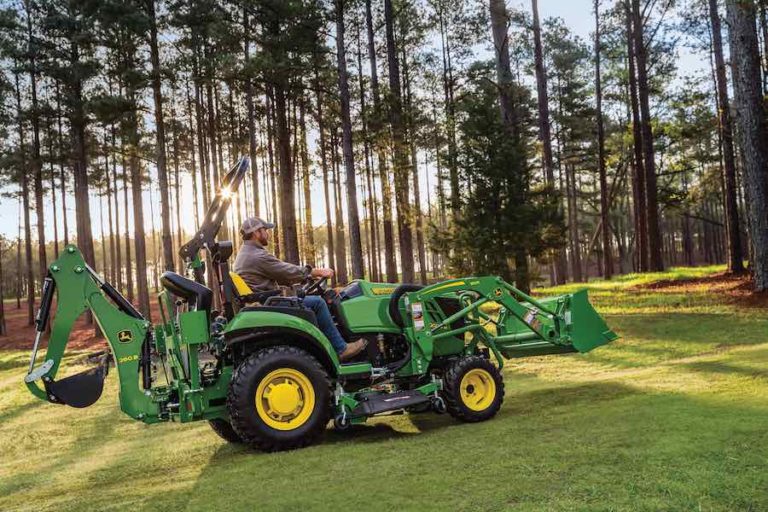By John Kmitta
Tractors are the Swiss Army knife of equipment. These multipurpose machines provide an effective tool to maintain play-ready fields, said Ray Gherardini, product marketing manager, John Deere.
“Implements transform the machine to tackle a variety of jobs, from aeration to seasonal work such as snow removal,” he added.
Whether you purchase or lease a tractor, there are plenty of factors to consider when looking at these versatile workhorses.
Not your grandpa’s tractor

“Tractors have come a long way since the tractors our grandparents used,” said Sam Williamson, national golf and turf sales manager, Steiner. “Manual transmissions to hydrostatic, cruise control, and independent PTO control are just a few of the innovations that have assisted with improving sports field managers’ jobs.”
“There have been numerous technological advancements for tractors in recent years that make the sports field manager’s job a whole lot easier,” said David Taylor, owner, STEC Equipment, and Kioti tractor dealer. “For starters, having computers within the tractor helps more quickly identify and resolve any maintenance issues. Locking cruise control, meanwhile, allows the operator to easily maintain a slow, steady speed for lengthy tasks such as aerification. Automatic power takeoff (PTO) – and the ability to turn four-wheel drive on and off – allows for much more precise turns. Together, these innovations make tractors easier to use, safer and more versatile with added functionalities.”
“Manufacturers are consistently developing new features that help to simplify operation and boost productivity,” said Gherardini.
Gherardini points to John Deere’s Smart Connector as an example of such technology. Smart Connector establishes a connection between your tractor and your smartphone via Bluetooth technology for access to tractor information such as service intervals, diagnostic codes, fuel level, engine hours and maintenance information. Also, John Deere’s TractorPlus App provides owners with access to key parts of their operator’s manual, parts diagrams, and parts ordering directly from the John Deere Store or their preferred dealer, he added.
According to Brandon Bozarth, product manager for tractors and implements at Mahindra Ag North America, manufacturers are also making implements easier to attach, while transmission advancements have made changing direction easier.
Getting attached
According to Williamson, tractor attachments and implements such as mowers, aerators, seeders, trenchers and vacuums allow sports field managers to solve a wide range of issues.
“Each turf manager knows his or her field the best, therefore they know how to maintain it very well, and tractors allow them to complete these tasks in a timely and efficient fashion,” said Williamson.
According to Gherardini, compact utility tractors can be transformed using a vast array of implements to tackle just about any task.
“Through the simple addition of implements – hundreds of which are available for purchase – a compact utility tractor can be used for everything from digging and trenching to grading and moving materials, as well as mowing,” said Gherardini.
Some of the more popular implements include loaders, box blades, rotary tillers and backhoes, Gherardini added.

According to Bozarth, loaders can move dirt or sod, backhoes can dig up sod and dirt if it needs to be moved or replaced, and 3-point finish mowers can deliver belly-mower level finish on a larger machine.
“The wide array of attachments and implements that can be used with tractors for maintaining a sports field is precisely what makes tractors such a powerful, versatile workhorse to get the job done,” said Taylor.
Taylor added that the most common attachments for sports field managers are wide area mowers.
“Rather than buying a separate engine for a self-propelling mower, you can use the horsepower and auxiliary hydraulics of the tractor to properly utilize a wide area mower,” he said.
When it comes to matching a tractor to the requirements of implements, tractor horsepower-to-attachment ratio is key with whatever job you are trying to complete, said Williamson.
“Lift capacity, PTO horsepower, and torque all need to be factored into your decision,” said Williamson. “This is why, when purchasing a tractor, it is important to research and be honest with your dealer about what jobs you are wanting too complete. Typically, the safe bet is having more horsepower than what is required. The issue you can run into then is the size of the tractor. The higher the horsepower the larger the engine and therefore the larger the tractor.”
According to Taylor, before you buy a tractor, be sure to check the implement manufacturer’s spec requirements to be sure the tractor is within the recommended horsepower range and has sufficient lift capacity.
“You want to avoid overpowering or under-lifting the implement,” Taylor added. “I always advise my customers to opt for a tractor with 10 more horsepower than they think they’ll actually need. As you upgrade your machinery, you’ll always need more horsepower. You should also consider what kind of transmission your implements need, whether your implements require rear remotes and what PTO speeds they’ll require.”
Bozarth added that the latest Environmental Protection Agency regulations have led almost all manufacturers to use diesel exhaust fluid (DEF) on tractors 75 engine horsepower and above. If you can complete your tasks with a tractor smaller than this, it will cut out one more input to your operation, he said.
According to Gherardini, sports field professionals should work with their dealer to discuss their needs in a machine, including the specs required for their existing implements. A dealer will be able to help with navigating all of the options to determine the right machine for the intended jobs.
Deciding factors

When looking to buy or lease a tractor for sports field management applications, there are several other factors sports field managers should consider when making their decision.
Fields/facilities
According to Taylor, the type of field/facility being managed will determine what tasks you wish to accomplish with your tractor and, in turn, what tractor will meet your needs.
“In addition to the facility being maintained, sports field managers should also consider where the tractor will be stored, as well as how the tractor gets into the stadium,” said Taylor. “These factors can impact the size of the tractor that makes sense for your facility.”
“Base your purchase off the jobs you need to complete and the playing surface,” said Williamson. “Tire options, footprint, maneuverability, horsepower, and attachments are all things that need to be considered.”
Site considerations
“Think about the property that will be maintained, including terrain, size, and site access,” said Gherardini. “It is important to select a machine that can handle the intended facilities, while also ensuring that it is able to travel throughout the property. For example, are there any gates that the tractor would travel through to access the field? That will be a factor in the purchase.”
“Maneuverability and footprint are two large aspects that need to be checked. If your tractor will not fit or work on your site, it isn’t much support to you and your team,” said Williamson. “Soft conditions, for example, require a lighter footprint. Fitting your tractor to your surfaces is a must.”
Said Bozarth, “Most sports management jobs must watch compaction on grassy areas. Watch for a machine with an appropriate weight and turf or golf tires to spread the weight out.”
Added Taylor, “If you’re working in a dusty environment or in extreme heat or cold, you may want a tractor with a cab. If there are lots of trees in the vicinity of the field, an open station tractor is probably better for you.”
Workload
According to Gherardini, sports field managers should also determine the type of work that will be done. This will help to identify the right engine horsepower and hitch lift capacity for the tasks that are being tackled on a regular basis.
According to Taylor, the heavier your workload, the bigger horsepower and greater lift capacity you’ll need in a tractor.
“Horsepower and kits such as buckets, hydraulics, and electrical need to be properly set up to make sure the job can be completed,” said Williamson. “Maintenance and support provide what is needed to keep your unit going for years to come.”
Operator comfort and safety
“It is always smart to demo or operate the unit you are looking at before purchasing,” said Williamson. “Operator comfort can be investigated through this process and make sure that hours of operation do not cause discomfort. A comfortable operator does a better job running their machine.”
According to Taylor, having a cab on a tractor is a major advantage for both comfort and safety considerations. It can keep the operator warm in the cold or cool in the heat, and can prevent dust and debris from interfering with the operator.
Overall, Williamson advises sports field managers to base their tractor purchases on the playing surface and the jobs that need to be completed.
“Tire options, footprint, maneuverability, horsepower and attachments are all things that need to be considered,” said Williamson.
Added Bozarth, “Find a unit with a lengthy warranty backing it up. Although your machine shop may be capable of many kinds of maintenance, knowing your local dealer is there to help will surely come in handy.”
“Do your research before deciding on a tractor,” said Taylor. “Speak with multiple dealers, and find someone else in the sports turf care industry who knows about the equipment to consult with. Take care to seek out advice from professionals who know the industry.”
John Kmitta is associate publisher/editorial brand director of SportsField Management.


